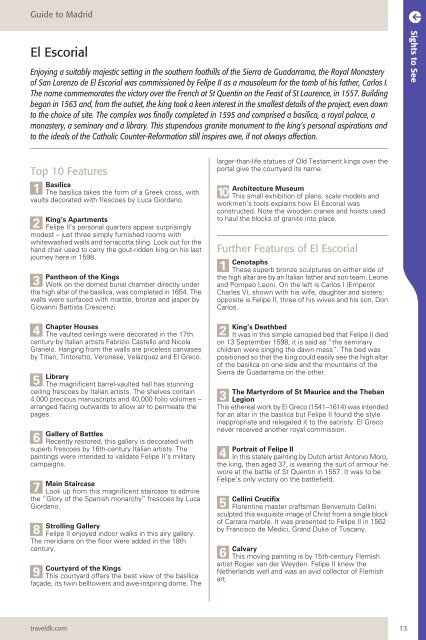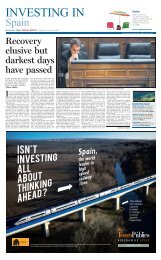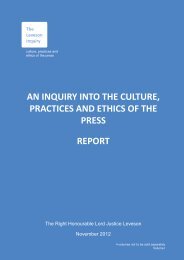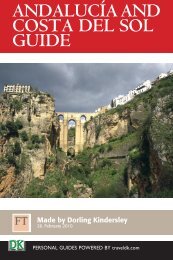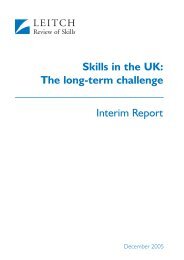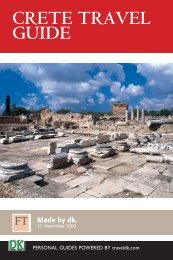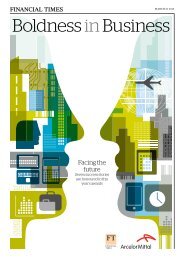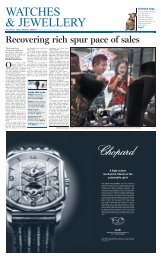You also want an ePaper? Increase the reach of your titles
YUMPU automatically turns print PDFs into web optimized ePapers that Google loves.
Guide to Madrid<br />
El Escorial<br />
Enjoying a suitably majestic setting in the southern foothills of the Sierra de Guadarrama, the Royal Monastery<br />
of San Lorenzo de El Escorial was commissioned by Felipe II as a mausoleum for the tomb of his father, Carlos I.<br />
The name commemorates the victory over the French at St Quentin on the Feast of St Laurence, in 1557. Building<br />
began in 1563 and, from the outset, the king took a keen interest in the smallest details of the project, even down<br />
to the choice of site. The complex was finally completed in 1595 and comprised a basilica, a royal palace, a<br />
monastery, a seminary and a library. This stupendous granite monument to the king’s personal aspirations and<br />
to the ideals of the Catholic Counter-Reformation still inspires awe, if not always affection.<br />
Top 10 Features<br />
1 Basílica<br />
The basílica takes the form of a Greek cross, with<br />
vaults decorated with frescoes by Luca Giordano.<br />
2<br />
King’s Apartments<br />
Felipe II’s personal quarters appear surprisingly<br />
modest – just three simply furnished rooms with<br />
whitewashed walls and terracotta tiling. Look out for the<br />
hand chair used to carry the gout-ridden king on his last<br />
journey here in 1598.<br />
3<br />
Pantheon of the Kings<br />
Work on the domed burial chamber directly under<br />
the high altar of the basílica, was completed in 1654. The<br />
walls were surfaced with marble, bronze and jasper by<br />
Giovanni Battista Crescenzi.<br />
4<br />
Chapter Houses<br />
The vaulted ceilings were decorated in the 17th<br />
century by Italian artists Fabrizio Castello and Nicola<br />
Granelo. Hanging from the walls are priceless canvases<br />
by Titian, Tintoretto, Veronese, Velázquez and El Greco.<br />
5 Library<br />
The magnificent barrel-vaulted hall has stunning<br />
ceiling frescoes by Italian artists. The shelves contain<br />
4,000 precious manuscripts and 40,000 folio volumes –<br />
arranged facing outwards to allow air to permeate the<br />
pages.<br />
6<br />
Gallery of Battles<br />
Recently restored, this gallery is decorated with<br />
superb frescoes by 16th-century Italian artists. The<br />
paintings were intended to validate Felipe II’s military<br />
campaigns.<br />
7<br />
Main Staircase<br />
Look up from this magnificent staircase to admire<br />
the “Glory of the Spanish monarchy” frescoes by Luca<br />
Giordano.<br />
8<br />
Strolling Gallery<br />
Felipe II enjoyed indoor walks in this airy gallery.<br />
The meridians on the floor were added in the 18th<br />
century.<br />
9<br />
Courtyard of the Kings<br />
This courtyard offers the best view of the basílica<br />
façade, its twin belltowers and awe-inspiring dome. The<br />
traveldk.com<br />
larger-than-life statues of Old Testament kings over the<br />
portal give the courtyard its name.<br />
10<br />
Architecture Museum<br />
This small exhibition of plans, scale models and<br />
workmen’s tools explains how El Escorial was<br />
constructed. Note the wooden cranes and hoists used<br />
to haul the blocks of granite into place.<br />
Further Features of El Escorial<br />
1 Cenotaphs<br />
These superb bronze sculptures on either side of<br />
the high altar are by an Italian father and son team, Leone<br />
and Pompeo Leoni. On the left is Carlos I (Emperor<br />
Charles V), shown with his wife, daughter and sisters;<br />
opposite is Felipe II, three of his wives and his son, Don<br />
Carlos.<br />
2<br />
King’s Deathbed<br />
It was in this simple canopied bed that Felipe II died<br />
on 13 September 1598, it is said as “the seminary<br />
children were singing the dawn mass”. The bed was<br />
positioned so that the king could easily see the high altar<br />
of the basilica on one side and the mountains of the<br />
Sierra de Guadarrama on the other.<br />
3<br />
The Martyrdom of St Maurice and the Theban<br />
Legion<br />
This ethereal work by El Greco (1541–1614) was intended<br />
for an altar in the basilica but Felipe II found the style<br />
inappropriate and relegated it to the sacristy. El Greco<br />
never received another royal commission.<br />
4<br />
Portrait of Felipe II<br />
In this stately painting by Dutch artist Antonio Moro,<br />
the king, then aged 37, is wearing the suit of armour he<br />
wore at the battle of St Quentin in 1557. It was to be<br />
Felipe’s only victory on the battlefield.<br />
5<br />
Cellini Crucifix<br />
Florentine master craftsman Benvenuto Cellini<br />
sculpted this exquisite image of Christ from a single block<br />
of Carrara marble. It was presented to Felipe II in 1562<br />
by Francisco de Medici, Grand Duke of Tuscany.<br />
6 Calvary<br />
This moving painting is by 15th-century Flemish<br />
artist Rogier van der Weyden. Felipe II knew the<br />
Netherlands well and was an avid collector of Flemish<br />
art.<br />
13<br />
Sights to See


